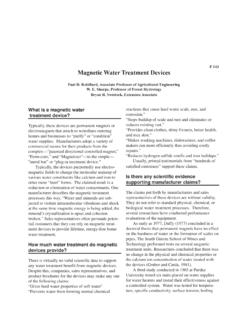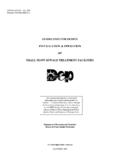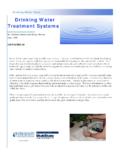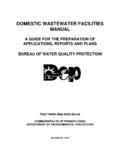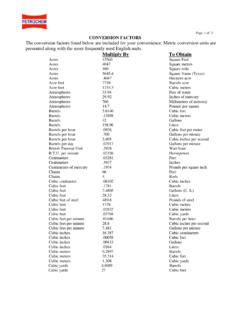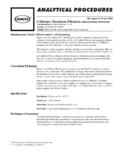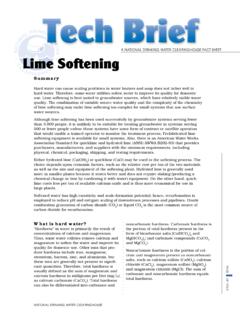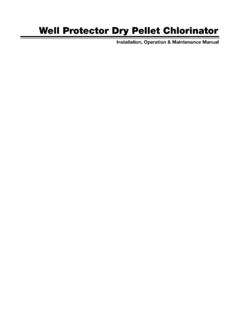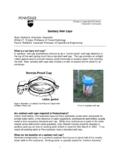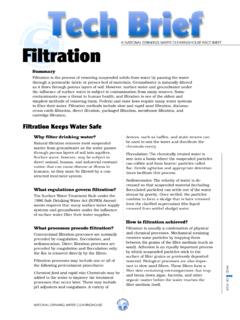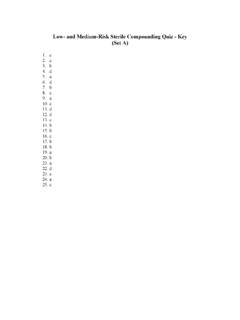Transcription of SOURCE IDENTIFICATION OF SODIUM AND …
1 1 SOURCE IDENTIFICATION OF SODIUM AND CHLORIDE CONTAMINATION INNATURAL WATERS: PRELIMINARY Panno, Hackley, Hwang, S. greenberg , Krapac, S. Landsberger and O KellyABSTRACTS odium-chloride (Na+- Cl-) contamination in groundwater and surface water in rural and urbanareas of Illinois and the is widespread. The input of Na+ and Cl- from road salt in the , seawater intrusion along coastal areas, animal and human waste in rural areas, leakinglandfills and natural saline seeps in other areas has created progressively worsening problems withwater quality in some municipal and private wells. In addition, elevated concentrations of Na+ andCl- have adversely affected the biodiversity of wetland areas and waterways. These problems areespecially acute in areas of the that are experiencing rapid growth. Water samples collected (primarily in Illinois) from streams, springs and wells containing elevatedNa+ and Cl-, and from likely sources of Na+ and Cl- contamination were analyzed for a variety ofparameters.
2 The data from these analyses were examined graphically and scrutinized for trends andclustering in order to characterize likely sources of contamination of affected waters. The halides,Br-, Cl- and I-, in conjunction with cations and other anions, total N, dissolved organic carbon, stableisotopes (including *D, *18O, *13C, *15N and *18O of the NO3- ion), tritium and their ratios werefound to be effective in connecting most of the contaminant sources with their affected waters. Theuse of mixing curves proved to be an effective means of identifying sources of Na+ and Cl- whenapplied to specific study areas. Thus, the methods applied in this investigation may make it possibleto identify the sources of Na+ and Cl- contamination in natural of groundwater and surface water by Na+ and Cl- is a common occurrence ingrowing urban areas (Mason et al. 1999; Buttle and Labadia, 1999; Naftz and Spangler, 1994) andadversely affects municipal and private water supplies in Illinois and other states (Moyland, 1980;Cleary, 1978; Richard Rice, ISGS, personal communication, 1999).
3 Removal of Cl- from a watersupply is usually not an option because of the expense of desalination. Increasing concentrations ofthese ions in groundwater and surface water can adversely affect environmentally-sensitive areassuch as wetlands. SODIUM and Cl- contamination within a wetland s watershed and recharge areascan destroy rare and endangered plant species (Wilcox 1986a, b; Grootjans et al. 1988; Panno et , 1999b, 2000).Sources for these ions related to human activities include road salt, effluent from industrialfacilities, leachate from municipal landfills, effluent from private and municipal septic systems, andsome agricultural chemicals. Natural sources include rock-water interactions, saline seeps, andminor atmospheric contributions. While the IDENTIFICATION and quantification of Na+ and Cl- in wateris a simple matter, the determination of the SOURCE or sources of Na+ and Cl- as contaminants insurface water and groundwater is problematic. It is first necessary to identify the SOURCE (s) of a2contamination problem in order to solve it.
4 Several approaches have been used to help identify thesources of Na+ and Cl- in natural waters ( , Whittemore, 1995; Davis et al. 1998), but thesetechniques are not always definitive. The Cl/Br ratio has been used successfully to study theformation of saline groundwater and brines from relatively deep geologic formations, and tocharacterize atmospheric precipitation, shallow groundwater, and domestic sewage (Davis et ). The conservation of Br- and Cl- during transport in groundwater make these halides and theirratios especially useful in determining surface water and groundwater movement under mostcircumstances. Characterization of a natural water may indicate its origin and evolution ( ,Appelo and Postma, 1994). Analyses of radioactive and stable isotopes are excellent indicators ofthe history and evolution of surface water and groundwater. For example, tritium, and potentially37Cl, *18O, and *13C, are useful indicators of the evolution of groundwater and surface water, andmay also be useful for fingerprinting contaminants (Clark and Fritz, 1997).
5 Panno et al. (2000) usedthese techniques to identify the likely sources of Na+ and Cl- contamination entering a fen in purpose of this investigation was to determine which geochemical and isotopic analysistechniques used alone, together, and/or in conjunction with basic geologic and hydrologic data, andland-use information, could definitively indicate the SOURCE (s) of Na+ and Cl- contamination insurface water and groundwater. The results presented are preliminary because samples are stillbeing collected and analyzed for a variety of parameters, and additional samples need to becollected. METHODSTo find indicators for the sources of Na+ and Cl- in groundwater and surface water, several endmembers were chemically and isotopically characterized. The term end member , as used here,refers to selected recognized sources of concentrated Na+-Cl- and uncontaminated waters. Streamwater and/or groundwater known to have been contaminated by a Na+-Cl- SOURCE were collected andanalyzed for ProceduresSixty three water samples were either collected or retrieved from the ISGS Isotope GeochemistrySection s sample archives (Table 1).
6 Forty water samples collected by the authors were analyzed inthe field for temperature, pH, Eh and specific conductance using meters that allow temperaturecompensation in accordance with field techniques as described in Wood (1981). Samples collectedfor cations and anions were passed through :m high-capacity filters and stored in polyethylenebottles. Cation samples were acidified in the field with ultra-pure nitric acid to a pH of < 2. Allsamples were transported to the laboratory in ice-filled coolers, and kept refrigerated atapproximately 4o C until analyzed. Twenty-three archived samples had been collected in the samemanner as described above, and had received partial analysis prior to retrieval. Previous analyseswere conducted under the same protocols as the samples collected for this 1. End members, affected water samples, and pristine water samples collected for thisinvestigation. Upper case IDs, here and on the figures, indicate background samples and end3members; lower case IDs indicate groundwater or surface water that has been affected bycontamination with a Na+-Cl- Numbers Location Date of Sampling Rainwater and Snow meltP1 East Central IL rainfall08/31/01P2 East Central IL rainfall and snow melt11/31/01 Surface StreamsR1 Miss.
7 River, Davenport, IA08/14/01R2 Miss. River, Quincy, IL 08/14/01R3 Miss. River, Chester, IL08/14/01R5 Miss. River, Louisiana08/06/01R6 Miss. River, Chester, IL11/15/01R7 Miss. River, Quincy, IL 11/15/01R9 Miss. River, Davenport, IA11/15/01 Uncontaminated AquifersA1 Ceiling seep, Mammoth Cave (KY) dome08/15/01A2 Ceiling seep, Mammoth Cave (KY) dome08/15/01A3 Private well, Hampshire, IL01/17/01A4 IDOT well, Hampshire, IL01/17/01A5 Background monitoring well near landfill, Kane Spring, Weldon, IL10/03/00A8 Well CHM96B, Mahomet aquifer, Champaign, Staff-99, Wedron aquifer, Champaign, CHM94B, Glasford aquifer, Champaign, CHM94A-2, Mahomet aquifer, Champaign, seep, Fogelpole Cave (IL) flowstone09/13/00 Fertilizersf1 Tile water from east-central IL10/18/01f2 Tile water from east-central IL04/25/00f3 Tile water from east-central IL04/25/00f4 Tile water from east-central IL02/28/02F5 Urea fertilizer03/21/01F6 Solution 28 fertilizer03/21/01f7 Field runoff from southwestern Illinois06/29/01 Road Salts1 Hampshire, IL subdivision contaminated well10/17/01s2 Hampshire, IL subdivision contaminated well10/17/01s3 South Elgin, IL contaminated monitoring well11/02/99s4 South Elgin, IL contaminated monitoring well01/18/00S5 Road salt - deionized water solution11/02/99 LandfillsL1 Northeastern Illinois unidentified landfill leachate09/03/92L2 Northeastern Illinois unidentified landfill leachate11/20/924L3 Northeastern Illinois unidentified landfill leachate12/04/91l4 Unidentified landfill mon.
8 Well (contaminated), South Elgin, IL 01/18/00l5 Unidentified landfill mon. well (contaminated), South Elgin, IL 01/18/00L6 Northeastern Illinois unidentified landfill leachate11/05/01L7 Northeastern Illinois unidentified landfill leachate11/05/01 Septic SystemsE1 Septic tank effluent: flushing of ion-X resin, Kane tank effluent, Kane Co. 01/18/00E3 Septic tank effluent, Monroe Septic tank effluent, Monroe Septic tank effluent, Monroe Culligan water softening pellets02/08/00E7 Septic tank effluent, Monroe Morton Salt water softening pellets12/18/01e11 Septic tank monitoring well (contaminated), NY 12/18/01e12 Septic tank monitoring well (contaminated), NY 12/18/01 Animal WasteW1 Hog waste lagoon effluent03/21/01W2 Hog waste effluent-affected well11/17/99W3 Hog waste effluent (Site A)09/05/01W4 Hog waste effluent (Site E)12/21/01w5 Site A monitoring well (contaminated)01/10/02w6 Site A monitoring well (contaminated)01/10/02w7 Site A monitoring well (uncontaminated)
9 01/10/02 Saline SeepsB1 Villa Grove, IL saline well07/10/97b2 Mahomet aquifer, saline seep-affected well10/03/00b3 Mahomet aquifer, saline seep-affected well10/19/00B4 Columbia, IL saline spring06/28/01B5 Equality, IL saline spring02/28/02b6 Well BY99, Mahomet aquifer, saline seep-affected wellPublished DataSWSeawater composition from Krauskopf (1979)-----------Cation concentrations in water samples were determined at the ISGS with a Thermo-Jarrell AshModel ICAP 61e Inductively Coupled Argon Plasma Spectrometer. Instrument operation, inter-element interference correction, background correction, and data collection were controlled usingThermoSPEC/AE software. Blanks, calibration check standards, and reference standards wereanalyzed with each sample set. Solution concentrations of anions also were determined at the ISGS using a Dionex 211i ion chromatograph with Ionpac AG14 Guard Column, Ionpac AS14 AnalyticalColumn, and Anion Self-Regenerating Suppresor-11 (4 mm) following EPA Method (Pfaff, 1993).
10 Analytes were measured with a CDM-3 conductivity detector cell with a DS4detection stabilizer. The eluent was treated with mM SODIUM carbonate and mM sodium5bicarbonate. Instrument operations and data collection were controlled using PeakNet A calibration check standard and blank were run with each sample and oxygen isotopic concentrations were determined at the ISGS using methods similar tothose described by Silva et al. (1994 and 2000) and Wassenaar (1995), with some modifications byHwang et al. (1999). Briefly, water samples collected for analysis of the *15N and *18O of the NO3-ion were placed into two-liter bottles and acidified with hydrochloric acid to a pH of < 2. Thesamples were first boiled under acidification to remove bicarbonate and dissolved CO2. Thedissolved organic matter and SO42- ions were removed to minimize contamination of the *18O in theNO3- ion by the oxygen in the SO42- ions and dissolved organic matter. Removal of the CO32- andSO42- ions also helped eliminate anion interference during the ion-exchange step for NO3-extraction.
